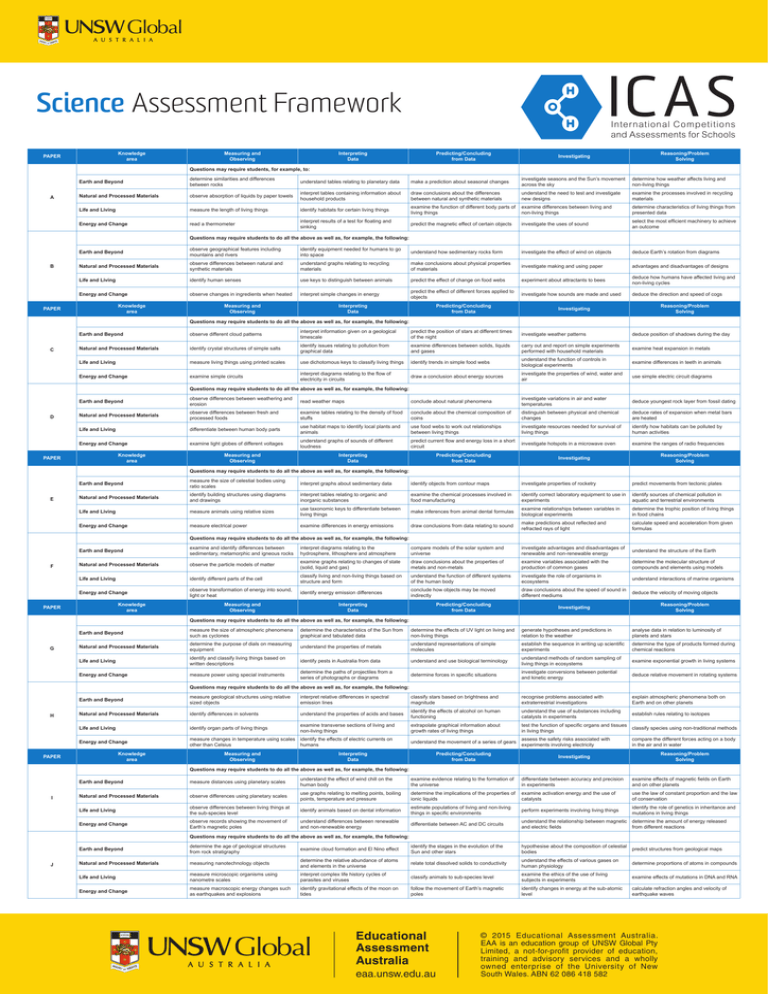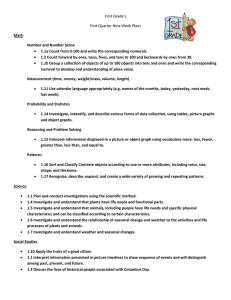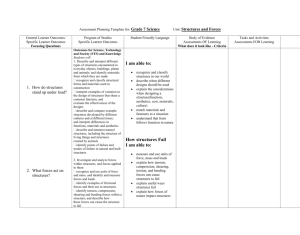Science Assessment Framework - Educational Assessment Australia
advertisement

ICAS Science Assessment Framework Knowledge area PAPER Measuring and Observing International Competitions and Assessments for Schools Interpreting Data Predicting/Concluding from Data Reasoning/Problem Solving Investigating Questions may require students, for example, to: A Earth and Beyond determine similarities and differences between rocks understand tables relating to planetary data make a prediction about seasonal changes investigate seasons and the Sun’s movement across the sky determine how weather affects living and non-living things Natural and Processed Materials observe absorption of liquids by paper towels interpret tables containing information about household products draw conclusions about the differences between natural and synthetic materials understand the need to test and investigate new designs examine the processes involved in recycling materials Life and Living measure the length of living things identify habitats for certain living things examine the function of different body parts of living things examine differences between living and non-living things determine characteristics of living things from presented data Energy and Change read a thermometer interpret results of a test for floating and sinking predict the magnetic effect of certain objects investigate the uses of sound select the most efficient machinery to achieve an outcome Questions may require students to do all the above as well as, for example, the following: B Earth and Beyond observe geographical features including mountains and rivers identify equipment needed for humans to go into space understand how sedimentary rocks form investigate the effect of wind on objects deduce Earth’s rotation from diagrams Natural and Processed Materials observe differences between natural and synthetic materials understand graphs relating to recycling materials make conclusions about physical properties of materials investigate making and using paper advantages and disadvantages of designs Life and Living identify human senses use keys to distinguish between animals predict the effect of change on food webs experiment about attractants to bees deduce how humans have affected living and non-living cycles Energy and Change observe changes in ingredients when heated interpret simple changes in energy predict the effect of different forces applied to objects investigate how sounds are made and used deduce the direction and speed of cogs Knowledge area PAPER Measuring and Observing Interpreting Data Predicting/Concluding from Data Reasoning/Problem Solving Investigating Questions may require students to do all the above as well as, for example, the following: C Earth and Beyond observe different cloud patterns interpret information given on a geological timescale predict the position of stars at different times of the night investigate weather patterns deduce position of shadows during the day Natural and Processed Materials identify crystal structures of simple salts identify issues relating to pollution from graphical data examine differences between solids, liquids and gases carry out and report on simple experiments performed with household materials examine heat expansion in metals Life and Living measure living things using printed scales use dichotomous keys to classify living things identify trends in simple food webs understand the function of controls in biological experiments examine differences in teeth in animals Energy and Change examine simple circuits interpret diagrams relating to the flow of electricity in circuits draw a conclusion about energy sources investigate the properties of wind, water and air use simple electric circuit diagrams Questions may require students to do all the above as well as, for example, the following: D Earth and Beyond observe differences between weathering and erosion read weather maps conclude about natural phenomena investigate variations in air and water temperatures deduce youngest rock layer from fossil dating Natural and Processed Materials observe differences between fresh and processed foods examine tables relating to the density of food stuffs conclude about the chemical composition of coins distinguish between physical and chemical changes deduce rates of expansion when metal bars are heated Life and Living differentiate between human body parts use habitat maps to identify local plants and animals use food webs to work out relationships between living things investigate resources needed for survival of living things identify how habitats can be polluted by human activities Energy and Change examine light globes of different voltages understand graphs of sounds of different loudness predict current flow and energy loss in a short circuit investigate hotspots in a microwave oven examine the ranges of radio frequencies Knowledge area PAPER Measuring and Observing Interpreting Data Predicting/Concluding from Data Reasoning/Problem Solving Investigating Questions may require students to do all the above as well as, for example, the following: E Earth and Beyond measure the size of celestial bodies using ratio scales interpret graphs about sedimentary data identify objects from contour maps investigate properties of rocketry predict movements from tectonic plates Natural and Processed Materials identify building structures using diagrams and drawings interpret tables relating to organic and inorganic substances examine the chemical processes involved in food manufacturing identify correct laboratory equipment to use in experiments identify sources of chemical pollution in aquatic and terrestrial environments Life and Living measure animals using relative sizes use taxonomic keys to differentiate between living things make inferences from animal dental formulas examine relationships between variables in biological experiments determine the trophic position of living things in food chains Energy and Change measure electrical power examine differences in energy emissions draw conclusions from data relating to sound make predictions about reflected and refracted rays of light calculate speed and acceleration from given formulas Questions may require students to do all the above as well as, for example, the following: F Earth and Beyond examine and identify differences between sedimentary, metamorphic and igneous rocks interpret diagrams relating to the hydrosphere, lithosphere and atmosphere compare models of the solar system and universe investigate advantages and disadvantages of renewable and non-renewable energy understand the structure of the Earth Natural and Processed Materials observe the particle models of matter examine graphs relating to changes of state (solid, liquid and gas) draw conclusions about the properties of metals and non-metals examine variables associated with the production of common gases determine the molecular structure of compounds and elements using models Life and Living identify different parts of the cell classify living and non-living things based on structure and form understand the function of different systems of the human body investigate the role of organisms in ecosystems understand interactions of marine organisms Energy and Change observe transformation of energy into sound, light or heat identify energy emission differences conclude how objects may be moved indirectly draw conclusions about the speed of sound in different mediums deduce the velocity of moving objects Knowledge area PAPER Measuring and Observing Interpreting Data Predicting/Concluding from Data Reasoning/Problem Solving Investigating Questions may require students to do all the above as well as, for example, the following: G Earth and Beyond measure the size of atmospheric phenomena such as cyclones determine the characteristics of the Sun from graphical and tabulated data determine the effects of UV light on living and non-living things generate hypotheses and predictions in relation to the weather analyse data in relation to luminosity of planets and stars Natural and Processed Materials determine the purpose of dials on measuring equipment understand the properties of metals understand representations of simple molecules establish the sequence in writing up scientific experiments determine the type of products formed during chemical reactions Life and Living identify and classify living things based on written descriptions identify pests in Australia from data understand and use biological terminology understand methods of random sampling of living things in ecosystems examine exponential growth in living systems Energy and Change measure power using special instruments determine the paths of projectiles from a series of photographs or diagrams determine forces in specific situations investigate conversions between potential and kinetic energy deduce relative movement in rotating systems Questions may require students to do all the above as well as, for example, the following: H Earth and Beyond measure geological structures using relative sized objects interpret relative differences in spectral emission lines classify stars based on brightness and magnitude recognise problems associated with extraterrestrial investigations explain atmospheric phenomena both on Earth and on other planets Natural and Processed Materials identify differences in solvents understand the properties of acids and bases identify the effects of alcohol on human functioning understand the use of substances including catalysts in experiments establish rules relating to isotopes Life and Living identify organ parts of living things examine transverse sections of living and non-living things extrapolate graphical information about growth rates of living things test the function of specific organs and tissues in living things classify species using non-traditional methods Energy and Change measure changes in temperature using scales other than Celsius identify the effects of electric currents on humans understand the movement of a series of gears assess the safety risks associated with experiments involving electricity compare the different forces acting on a body in the air and in water Knowledge area PAPER Measuring and Observing Interpreting Data Predicting/Concluding from Data Reasoning/Problem Solving Investigating Questions may require students to do all the above as well as, for example, the following: I Earth and Beyond measure distances using planetary scales understand the effect of wind chill on the human body examine evidence relating to the formation of the universe differentiate between accuracy and precision in experiments examine effects of magnetic fields on Earth and on other planets Natural and Processed Materials observe differences using planetary scales use graphs relating to melting points, boiling points, temperature and pressure determine the implications of the properties of ionic liquids examine activation energy and the use of catalysts use the law of constant proportion and the law of conservation Life and Living observe differences between living things at the sub-species level identify animals based on dental information estimate populations of living and non-living things in specific environments perform experiments involving living things identify the role of genetics in inheritance and mutations in living things Energy and Change observe records showing the movement of Earth’s magnetic poles understand differences between renewable and non-renewable energy differentiate between AC and DC circuits understand the relationship between magnetic and electric fields determine the amount of energy released from different reactions Questions may require students to do all the above as well as, for example, the following: J Earth and Beyond determine the age of geological structures from rock stratigraphy examine cloud formation and El Nino effect identify the stages in the evolution of the Sun and other stars hypothesise about the composition of celestial bodies predict structures from geological maps Natural and Processed Materials measuring nanotechnology objects determine the relative abundance of atoms and elements in the universe relate total dissolved solids to conductivity understand the effects of various gases on human physiology determine proportions of atoms in compounds Life and Living measure microscopic organisms using nanometre scales interpret complex life history cycles of parasites and viruses classify animals to sub-species level examine the ethics of the use of living subjects in experiments examine effects of mutations in DNA and RNA Energy and Change measure macroscopic energy changes such as earthquakes and explosions identify gravitational effects of the moon on tides follow the movement of Earth’s magnetic poles identify changes in energy at the sub-atomic level calculate refraction angles and velocity of earthquake waves Educational Assessment Australia eaa.unsw.edu.au © 2015 Educational Assessment Australia. EAA is an education group of UNSW Global Pty Limited, a not-for-profit provider of education, training and advisory services and a wholly owned enterprise of the University of New South Wales. ABN 62 086 418 582


